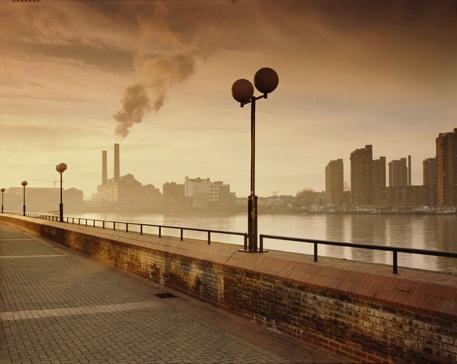
Photograph copyright ©1999 - 2018 Denis Waugh.
External Links
BATTERSEA
In World's End, on a small island across the river, just near the outlet of warm water from Lots Road power station, are no fewer than ten herons. It's probably a kind of heron spa. The youngsters engaged in learning kayak skills in the rapids will probably not be too concerned if they are tipped out, either.
The present Battersea Bridge was designed by Sir Joseph Bazalgette and completed by 1890 and I pause for thought on my way across. In the 1890s the new craze was bicycling. The first bike might be said to be the célérifère, built by the Comte de Sivrac in 1791. It consisted of two wheels joined by a bar with a wooden seat, astride which you sat and `walked' the bike along. But it was a start. The hobby horse, velocipede and penny farthing followed in quick succession until 1874 when H.J. Lawson produced the first chain-driven machine. The design has hardly changed since and I can state categorically that there has never - ever - been a more logical, efficient and affordable form of transport.
By 1896 bicycles were banned from Hyde Park and Battersea Park, within easy reach, was well used by cyclists. In fact it was packed with them. Those who were too nervous to participate were almost content just to watch. They probably felt a bit like I do when watching people surfing... but then I put the thought firmly back in the Too Difficult Box and get back on my bike.
Once upon a time - about twenty years ago - the ugliest pub in Christendom was on the Battersea waterfront, not far from where the once again highly fashionable Battersea Village has rematerialized. There was also, I seem to remember, a harmless eccentric living on a ramshackle barge. There were Plans for the area though, and mysteriously, one night, the barge was burned out and the inhabitant disappeared. Now, from the terrace of smart houses comes the clink of glasses and snatches of sophisticated conversation.
The area is very desirable now. No hermits, no eccentrics. The up-market flats on the riverfront are in buildings named to reflect the river's trading history: Molasses House, Calico House, Ivory House, Plantation Wharf... and yes, it is very attractive.
For a little while in the 1990s there was an eco-village here, named Land and Freedom. It housed a group of young squatters proclaiming their right to trespass. They were not freeloaders, but idealists. Leo, recycling bits of old bikes to make new ones, told me: `Anyone can come here as long as they contribute. If you just want to sit around and drink beer you're not welcome.' Tiny gardens were scratched out of land and surrounded with stones with irrigation systems made from old drainpipes and plastic bottles. Notices abounded: Homes for Heroes... People not Profit... Make the Wasteland Grow... They planted vegetables to grow on a rotation system, but of course they never really had time for a rotation system to get going.
Battersea has always had particularly fertile soil. At the time of the Norman Conquest `Badric's Island' was a thriving Saxon settlement and St Mary's of Battersea was here, even then; the ancient building, however, was replaced in 1777 by the present simple village church, in time for William Blake to marry the daughter of a local market gardener in 1782. Catherine Boucher was talented but illiterate - she signed the marriage register with an `x' - and she worshipped Blake. Their domestic cleansing arrangements were not a priority. Catherine insisted: `But Mr Blake don't dirt!'
Nearby is where the River Wandle meets the Thames. The creek at present is a feeding and over-wintering ground for a variety of birds: kingfishers, pintail ducks, sandpipers, redshanks, wagtails - but their arrangements may have to change if the gleam in the developers' eye for an upmarket marina is to come about.
Sainsbury and Safeway, twin monuments to our culture, confront each other across the water and I wonder what the author of `Jerusalem' would have made of it all.
Text copyright ©1999 - 2018 Priscilla Waugh.